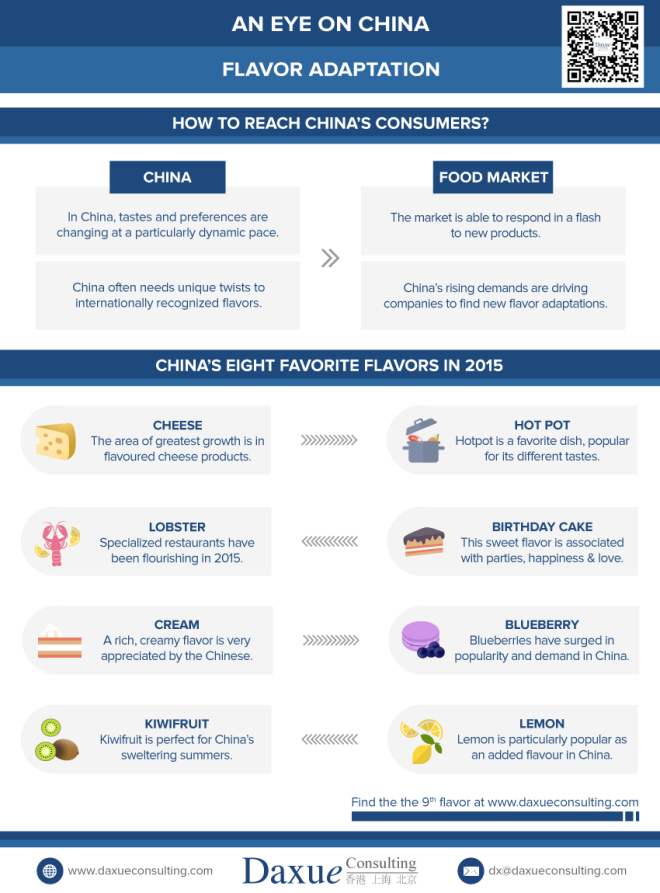
Delivering products capable of fully satisfying customers is the primary goal of any company. Food products especially must be aligned with people’s tastes and flavor preferences, but what works in one country does not necessarily tickle the palette in another. Flavor adaptation is a key element to reaching the largest food consumer market in the world; China. Want Want Holding Ltd. is the second largest snack producer in China after Kraft. The Taiwanese company is a great example of how important it is to put serious emphasis on flavor adaptation in China and shows the how a satisfied market rewards the investment. The food industry environment is changing fast in China. While international corporations used to enjoy higher trust from the Chinese consumer, an increasing number of people are beginning to trust local brands more thanks to the introduction of improved certification labels and the diminishing number of health scandals (though they still occur with frightening regularity). Domestic competition is strengthening but international companies can doubly benefit from its good reputation and local preferences by acknowledging the importance of flavor adaptation in China.
Flavor adaptation in China’s taste preferences
Chinese tastes and perception of different food categories often varies significantly from Western perspectives. For example, many Chinese consider drinking coffee as purely a social activity to enjoy during their spare time, in contrast to Westerners, who often drinking coffee at home and at work as a . Chocolate is also seen very differently, considered a luxury food in China, whereas in the West it is often considered more of a snack. Despite China being a particularly large country with many distinct traditional cultures, general trends for taste preferences are relatively universal, and they can be drawn to upon to effectively adapt food in China.
Beef & spicy chicken flavor
Beef & spicy chicken are the most enjoyed meat flavors, aligned with local Chinese dishes that frequently contain beef, often boiled or fried rather than grilled, and spicy chicken. KFC has been enjoying phenomenal expansion thanks to its spicy chicken burger, and its success doesn’t appear to be fading in the face of the traditional burger chains springing up in the country. Kraft is similarly conscious of the importance of flavor adaptation in China and has even modified their successful American Ritz Cracker for a Chinese version (a tomato biscuit with beef and chicken flavor).
Light flavor
An interesting trend observed in China is the rising demand for light flavor products. Just like in the beverage industry, “light flavour” is associated with a taste suggestive of limited flavor modification and a healthier product. It should be noted that the extent of modification is not typically researched by Chinese consumers; they are happy to consume products that don’t appear to be artificially flavoured, regardless of whether or not they actually are. This preference is gaining more and more importance. Strong tastes, such as cheese and cream, are still very popular as snacks. However, particularly in the beverage industry, a taste with less overt flavour will have an easier time entering the Chinese market than the ones with a strong or obvious flavour. Cheese flavor is, however, used to promote products, as it is easily identifiable and evocative, and has an exotic twist to it that appeals to younger, more experimental urban consumers.
Flavor localization
Flavor localization since always been a great way to reach the Chinese customer, but this strategy must be used with close attention, since flavor localization doesn’t guarantee success in China, or even from city-to-city in some cases. The giant Coca-Cola group failed to implement its tea beverages in spite of large financial support as the artificiality of the taste was not accepted by domestic consumers; for them, Coca-Cola is a soda company. Demands and needs must be analysed very carefully though surveys and product testing. Companies go beyond flavor localization as domestic competition is strengthening up.
Packaging
Of course, adaptation mustn’t stop at flavors; designs and colours for packaging must be chosen carefully, according to perceptions and positioning of food in China. This is illustrated by the fact that consumers tend to love small and delicate packing for chocolate such as Hershey’s Chinese KISS Chocolate, rather than the chunkier, brick-like, traditional chocolate factory packaging.
Permanent changes in tastes and flavor adaptation in China
In 2012, Nestle decided to adapt its products towards chocolate milk despite having been in the market for 15 years. Experiencing new products and tastes is highly valued by the Chinese consumer, used to a fast changing environment and eager to try new things (and discard old things!). New tastes are in high demand, to the extent that Nestle founded 3 research centres fully dedicated to flavor adaptation in China. One of those centres has been developing a new kind of candy perfectly designed to the Chinese demand, with extensive research into flavor improvement; there are suggestions that they will be pushing for a milk-candy focus.
Ongoing innovation is desperately required in China, as customers don’t tend to be very loyal and will explore competitor’s offerings if they become bored with old tastest. XUFUJI has recently been facing a decline in sales as its offering hasn’t change very much. It is failing to adapt to the changing tastes of the Chinese customers. To face this difficulty, XUFUJI claims they will be coming up with optimised and improved ingredients and reach many more customers. Kraft’s Oreos are in the same situation, the biscuits have been particularly successful for many years and can today be bought in nearly every store but sales are dropping as people are getting tired of the taste; to address this, newer tastes have been steadily introduced in the last five years.
Adapt to China or wait for China to adapt?
Entering the Chinese market with a new food product or brand can be accomplished with two very different strategies. Should the product be adapted to Chinese customers or should the brand promote the product as it is and expect customers to change their habits or tastes? The most common strategy is flavor adaptation, however preferences are changing so fast that some companies prefer maintaining their original product and putting efforts into guiding consumer tastes to be more in-line with the product. Classes, education, tasting events and product ambassadors have worked quite well for the wine industry, while branding campaigns, sponsorships and some limited adapted offerings have had similar success for burger chains like MacDonald’s, Burger King and Carls Junior. Another company benefiting from branding efforts and the general shift in tastes towards dairy products is Mars Corporation, the latest multinational to be promoting a chocolate strategy. After 15 years of revenue losses, returns are starting to pay off as consumers slowly but surely begin to consumer more chocolate. Nespresso has similarly decided to put effort into changing habits and is promoting home consumption of coffee in order to boost its sales and performance, though their taste remains niche as it’s considered too bitter.
We believe that the best way to enter the Chinese market is to put the product through rigorous focus testing, before deciding whether the taste is in line with the general changing trend in China’s preferences, or whether the product is the latest in a long line that required some flavour adaptation in China.
Wants more market reports in China? Follow us on LinkedIn at this link and scan our QR codes in the sidebar to reach us on Wechat !

Sources
https://www.ft.com/intl/cms/s/0/83a60866-b2d3-11e4-a058-00144feab7de.html
https://www.cnn.com/2010/LIVING/homestyle/04/08/fast.food/
https://www.wsj.com/articles/SB10001424127887324784404578142931427720970




